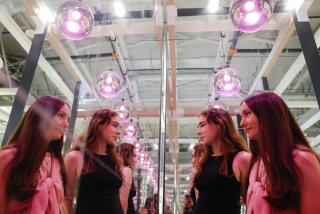Look, inspiration for less!
- Share via
THE 2007 IKEA catalog dropped with a global 80,000-ton thud a few weeks ago. Though its arrival hardly rates on the American cultural calendar, it’s something of a phenomenon in Europe, where shelter catalogs aren’t so plentiful.
Still, publishing 160 million catalogs a year worldwide (20 million in the United States) is a retail achievement nonpareil. By way of comparison, three years after its release, Dan Brown’s “The Da Vinci Code” has about 60 million copies in print.
The catalog is dizzying, its 370 pages the two-dimensional equivalent of the store’s labyrinthine showrooms. But what popped out this year was a page of postage-stamp-size, black-and-white portraits of IKEA’s design team. They were arranged like a school yearbook, 26 of them, their vowel-heavy Swedish names in small red type. On later pages they reappeared individually next to their latest creations.
Was this a subtle allusion to Design Within Reach or a more deliberate poke? Since its debut in 1999, black-and-white portraits of furniture designers have been a hallmark of DWR’s catalog, essential to the way that each object is presented as a work of art. For instance this description: “Inspired by the construction of a sophisticated sailboat, designer Luciano Bertoncini created his Aladina Chair (2005) to be incredibly strong as well as delightfully lightweight.” With little rearranging, this text could become an exhibit label on a museum wall.
DWR elevated the catalog to stylish reading material. It edged retail closer to shelter magazines, just as magazines were adopting so many qualities of catalogs.
While they entreat wallets at opposite ends of the economic spectrum, IKEA and DWR have some things in common. Both started as mail-order businesses; IKEA in Sweden in 1943, DWR in San Francisco in 1998. Both emphasize highly functional European design. IKEA opened its first showroom in 1953 and has continued to grow steadily, now with 236 stores in 34 countries and territories, and only in recent years has returned to direct-shipping sales.
DWR, undertook rapid expansion into brick-and-mortar shops (called design studios) in 2003 and 2004, and has yet to regain its financial equilibrium.
Their wares overlap more than either company would like to admit. We all know “molded nylon” is just a fancy way of saying plastic. Try playing the $90 or $900 game: OK... the item is a metal TV stand with a glass shelf and plastic casters. That’s a trick question. It’s $748 at DWR, designed by Bertoncini, and $49.99 at IKEA, designed by Niels Gammelgaard.
But no one would confuse the catalogs’ pages. DWR’s have an architectural presentation, all modular hairline boxes, sans-serif type and tidy measurement schematics. Every sleeper sofa and bar stool is photographed with minimal set-dressing and movie-star lighting.
Ikea’s pages are a riot of visual information, underscoring the fact that every single object in every tableaux is for sale. The tea kettle in the kitchen? The bedside alarm clock? Just two of the 12,000 or so items for sale at an IKEA near you.
Yet the opening pages of the 2007 IKEA catalog present a series of lifestyle manifestos that seem almost Buddhist. “What’s happening in your life?” demands the headline type on the cover overleaf. “Are you so busy working working working, running running running, seeing seeing seeing, that you’ve forgotten the lovely art of just being, at home....Are you too preoccupied with the extravagant and extraordinary, while real life is actually something that’s happening right here, right now.”
It is the DWR catalog that one expects to have a manifesto, something adapted and updated from the modernists of the early 20th century. And while the September/October catalog is a bit more hefty at 120 pages, up from the usual 100 -- there’s a certain sameness to it, even with 30 new items.
Just as IKEA co-opted DWR’s designer-worship, maybe DWR should appropriate some ideas from the Scandinavian giant -- perhaps starting with an encyclopedic catalog whose arrival is an annual event.
More to Read
The biggest entertainment stories
Get our big stories about Hollywood, film, television, music, arts, culture and more right in your inbox as soon as they publish.
You may occasionally receive promotional content from the Los Angeles Times.









